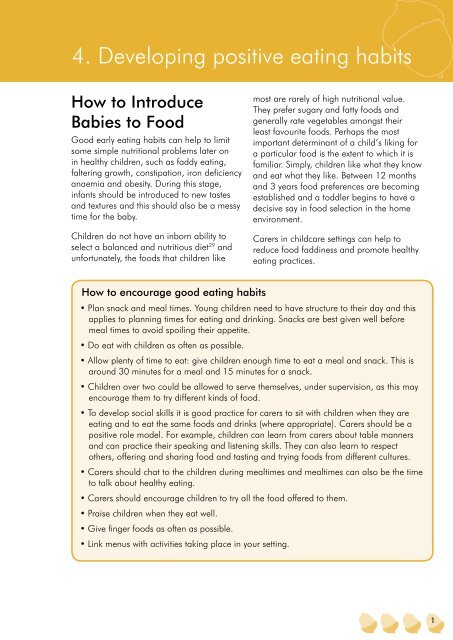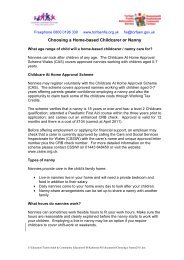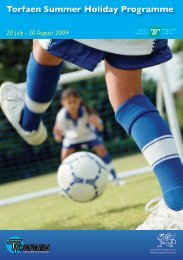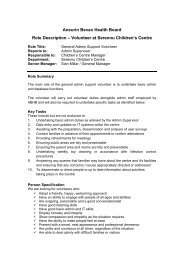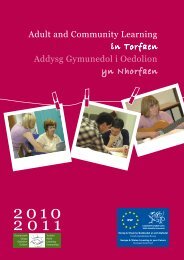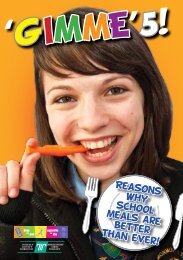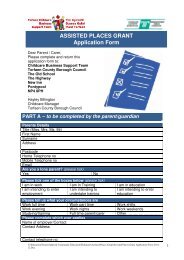Food and Health Guidelines - Torfaen Family Information Service
Food and Health Guidelines - Torfaen Family Information Service
Food and Health Guidelines - Torfaen Family Information Service
You also want an ePaper? Increase the reach of your titles
YUMPU automatically turns print PDFs into web optimized ePapers that Google loves.
4. Developing positive eating habits<br />
How to Introduce<br />
Babies to <strong>Food</strong><br />
Good early eating habits can help to limit<br />
some simple nutritional problems later on<br />
in healthy children, such as faddy eating,<br />
faltering growth, constipation, iron deficiency<br />
anaemia <strong>and</strong> obesity. During this stage,<br />
infants should be introduced to new tastes<br />
<strong>and</strong> textures <strong>and</strong> this should also be a messy<br />
time for the baby.<br />
Children do not have an inborn ability to<br />
select a balanced <strong>and</strong> nutritious diet 29 <strong>and</strong><br />
unfortunately, the foods that children like<br />
most are rarely of high nutritional value.<br />
They prefer sugary <strong>and</strong> fatty foods <strong>and</strong><br />
generally rate vegetables amongst their<br />
least favourite foods. Perhaps the most<br />
important determinant of a child’s liking for<br />
a particular food is the extent to which it is<br />
familiar. Simply, children like what they know<br />
<strong>and</strong> eat what they like. Between 12 months<br />
<strong>and</strong> 3 years food preferences are becoming<br />
established <strong>and</strong> a toddler begins to have a<br />
decisive say in food selection in the home<br />
environment.<br />
Carers in childcare settings can help to<br />
reduce food faddiness <strong>and</strong> promote healthy<br />
eating practices.<br />
How to encourage good eating habits<br />
• Plan snack <strong>and</strong> meal times. Young children need to have structure to their day <strong>and</strong> this<br />
applies to planning times for eating <strong>and</strong> drinking. Snacks are best given well before<br />
meal times to avoid spoiling their appetite.<br />
• Do eat with children as often as possible.<br />
• Allow plenty of time to eat: give children enough time to eat a meal <strong>and</strong> snack. This is<br />
around 30 minutes for a meal <strong>and</strong> 15 minutes for a snack.<br />
• Children over two could be allowed to serve themselves, under supervision, as this may<br />
encourage them to try different kinds of food.<br />
• To develop social skills it is good practice for carers to sit with children when they are<br />
eating <strong>and</strong> to eat the same foods <strong>and</strong> drinks (where appropriate). Carers should be a<br />
positive role model. For example, children can learn from carers about table manners<br />
<strong>and</strong> can practice their speaking <strong>and</strong> listening skills. They can also learn to respect<br />
others, offering <strong>and</strong> sharing food <strong>and</strong> tasting <strong>and</strong> trying foods from different cultures.<br />
• Carers should chat to the children during mealtimes <strong>and</strong> mealtimes can also be the time<br />
to talk about healthy eating.<br />
• Carers should encourage children to try all the food offered to them.<br />
• Praise children when they eat well.<br />
• Give finger foods as often as possible.<br />
• Link menus with activities taking place in your setting.<br />
1


